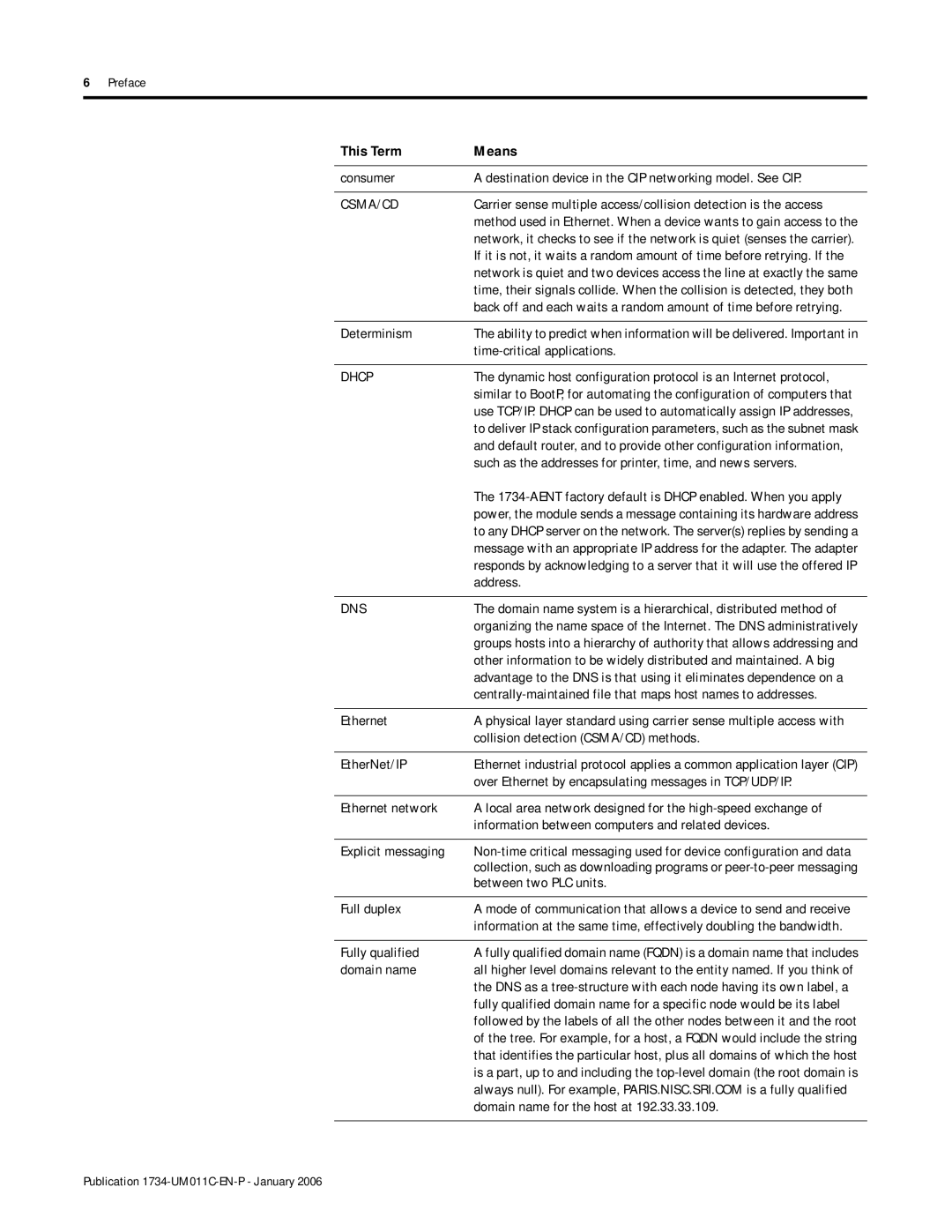6Preface
This Term | Means |
|
|
consumer | A destination device in the CIP networking model. See CIP. |
|
|
CSMA/CD | Carrier sense multiple access/collision detection is the access |
| method used in Ethernet. When a device wants to gain access to the |
| network, it checks to see if the network is quiet (senses the carrier). |
| If it is not, it waits a random amount of time before retrying. If the |
| network is quiet and two devices access the line at exactly the same |
| time, their signals collide. When the collision is detected, they both |
| back off and each waits a random amount of time before retrying. |
|
|
Determinism | The ability to predict when information will be delivered. Important in |
|
|
|
|
DHCP | The dynamic host configuration protocol is an Internet protocol, |
| similar to BootP, for automating the configuration of computers that |
| use TCP/IP. DHCP can be used to automatically assign IP addresses, |
| to deliver IP stack configuration parameters, such as the subnet mask |
| and default router, and to provide other configuration information, |
| such as the addresses for printer, time, and news servers. |
| The |
| power, the module sends a message containing its hardware address |
| to any DHCP server on the network. The server(s) replies by sending a |
| message with an appropriate IP address for the adapter. The adapter |
| responds by acknowledging to a server that it will use the offered IP |
| address. |
|
|
DNS | The domain name system is a hierarchical, distributed method of |
| organizing the name space of the Internet. The DNS administratively |
| groups hosts into a hierarchy of authority that allows addressing and |
| other information to be widely distributed and maintained. A big |
| advantage to the DNS is that using it eliminates dependence on a |
| |
|
|
Ethernet | A physical layer standard using carrier sense multiple access with |
| collision detection (CSMA/CD) methods. |
|
|
EtherNet/IP | Ethernet industrial protocol applies a common application layer (CIP) |
| over Ethernet by encapsulating messages in TCP/UDP/IP. |
|
|
Ethernet network | A local area network designed for the |
| information between computers and related devices. |
|
|
Explicit messaging | |
| collection, such as downloading programs or |
| between two PLC units. |
|
|
Full duplex | A mode of communication that allows a device to send and receive |
| information at the same time, effectively doubling the bandwidth. |
|
|
Fully qualified | A fully qualified domain name (FQDN) is a domain name that includes |
domain name | all higher level domains relevant to the entity named. If you think of |
| the DNS as a |
| fully qualified domain name for a specific node would be its label |
| followed by the labels of all the other nodes between it and the root |
| of the tree. For example, for a host, a FQDN would include the string |
| that identifies the particular host, plus all domains of which the host |
| is a part, up to and including the |
| always null). For example, PARIS.NISC.SRI.COM is a fully qualified |
| domain name for the host at 192.33.33.109. |
|
|
Publication
